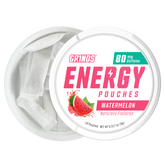Dip Withdrawal Symptoms: Common Side Effects of Quitting Chew Tobacco
Want to learn about the most common dip withdrawal symptoms? In this in-depth guide, we won't just share the most common side effects of quitting chew tobacco. You'll also learn how to cope with these symptoms and manage them to the best of your ability - until, finally, you no longer have those cravings you once did.
Quitting chewing tobacco is both a tough physical and a mental battle. Most of the symptoms of physical nicotine withdrawal will fade quickly within a few days—stuff like headaches, mouth sores, dizziness & fatigue.
Unfortunately, that's the easiest part. And if you're interested in learning more about what to expect when you quit dipping tobacco physically, we have a separate article on that. But today, we're to talk about the mental battle you're preparing to face.
Overcoming the mental hurdles of quitting smokeless tobacco will be much more involved. However, this is completely within your reach once you’re fully committed to the idea of kicking the chew to the curb.
In this article, you’ll learn how to take control of the way your mind thinks about chewing tobacco and override the way it automatically associates certain times and places with smokeless tobacco. This may sound impossible, but it’s actually easier than you might think!
First - what causes the tobacco dip withdrawal symptoms in the first place?
What Causes Psychological Dip Withdrawal Symptoms?
Ever since you started dipping, you have been conditioned to strongly associate chewing tobacco with certain times of the day and certain activities. These associations can be triggered by events (a phone call; a football game on TV; a night out with the guys) or by routines (driving to work; eating dinner; yard work on Sundays). By always consuming tobacco during these activities, your mind comes to believe that you can’t complete them or enjoy them without it.
When you take chewing tobacco out of the equation and find yourself in these situations that are strongly associated with chewing tobacco, your body thinks something isn’t right. It sends signals to let you know something’s up, and those signals are then felt by you as irritability, depression, and/or anxiety. It’s your body’s way of getting your attention and reminding you to feed your habit.
This is the nastiness of addiction at work. And we do have good news - these cravings won't last forever. Allow us to touch on the dip withdrawal symptoms timeline below.
What is the Dip Withdrawal Symptoms Timeline?
The dip withdrawal symptoms timeline varies from person to person. Some people may experience withdrawal symptoms within a few hours of their last dip, while others may not experience them for several days or even weeks.
Dip tobacco withdrawal symptoms can include cravings, irritability, anxiety, depression, and difficulty concentrating. These symptoms can make it hard to stick to quitting, but they typically peak within the first week and then gradually lessen over time.
In the meantime, though, you're probably wondering how to make the dip tobacco withdrawal symptoms stop so you can finally achieve peace. Keep reading...
How to Make the Quitting Dip Withdrawal Symptoms Stop
Once you get that message from your body, you reach for tobacco—likely without even thinking about it. “I want a dip,” is a conditioned reflex. The good news is it can be reversed. When your mind tells your body to be irritable or anxious due to an absence of nicotine, you can override that urge with logic.
Remind yourself that you don’t NEED to dip smokeless tobacco in these situations. You just want it. If you believe that you actually do want that dip, you’ll feel deprived of tobacco, and somehow find a way to justify taking the dip. Instead, when you notice your patience running short or your feelings of anxiousness, simply acknowledge that the reason why you’re feeling that way is due to the absence of nicotine.
Better yet, celebrate that feeling because it means you are abstaining from nicotine! If the urge to dip continues to fester after you’ve attempted to override it with logic, try a healthy, constructive distraction, like popping a Grinds Coffee Pouch.
Get a Suitable Replacement for Smokeless Tobacco
Having a tobacco dip alternative on hand will allow you to conquer your cravings effortlessly. And, that's where Grinds comes in. Our caffeine pouches help you quit smokeless tobacco once and for all.
And you can justify doing so knowing your chewing tobacco alternative is helping you along your journey to become the best version of yourself- whether that be in sports or in your professional life. With 50mg of caffeine in each of our tobacco and nicotine-free pouches, you'll have that extra boost to get you through the day.
Reprogramming Your Brain to Beat Cravings of Dipping Smokeless Tobacco
If this seems impossible or just plain ridiculous, think of it like this: It’s just like when you get a rumble in your stomach. Your conditioned reflex is to think I’m hungry and then reach for a snack—maybe even without thinking about it.
Have you ever been in a situation where you have a big dinner that evening, but you find yourself feeling hungry late in the afternoon? In that situation, you likely questioned your conditioned reflex and used logic to defeat it by telling yourself, “Dinner is only three hours away. I can’t spoil my appetite ahead of dinner!”
To use another analogy, it’s kind of like getting a new car and the turn signal is now on the left instead of the right like it was in your old car. For the first few weeks of driving your new car, even though you know the turn signal is on the left, you keep turning on your wipers on the right instead of your turn signal on the left.
But with time and repetition, you eventually learn to reach for the left instead of the right. Or, to reach for Grinds nicotine and tobacco-free chew instead of traditional smokeless tobacco.
How To Start Changing Your Behavior RIGHT NOW
Changing your behavior and habits is complex and won’t happen overnight. However, you can start chipping away at your conditioned reflexes right now by using a nicotine replacement when cravings and withdrawal pangs hit.
Remember: the goal is to separate tobacco from your routines and activities. To do this you should:
- Recognize and celebrate feelings of irritability and anxiousness as reminders that you are successfully abstaining from tobacco.
- Counter-condition your urge to dip with a healthy alternative, such as Grinds Coffee Pouches.
The ultimate goal here is to convince yourself that tobacco and nicotine do nothing for you, thus removing your desire to chew. When you answer your psychological withdrawal pangs with something other than tobacco and nicotine, you’re proving to yourself that you don’t actually need the tobacco and nicotine.
Final Thoughts on Dip Tobacco Withdrawal Symptoms & Side Effects of Quitting Dipping
Now that you know all the dip tobacco withdrawal symptoms from a mental standpoint, along with the side effects of quitting dipping from a physical standpoint, you should feel more confident in beginning the battle against nicotine.
Remember - the tobacco dip withdrawal symptoms timeline can range from a few days to a few weeks. But once it's over, it's mostly over. You still may need to reprogram your brain a bit when the cravings strike as a result of mind association, though - which is where our caffeine pouches come in. With Grinds in your arsenal, quitting smokeless tobacco gets a whole lot easier.
However, we also have a complete guide on how to quit chewing tobacco tips to guide you through the journey. We'll kick this nasty habit together - head over to our site and get the best solution for chewing tobacco withdrawal!




